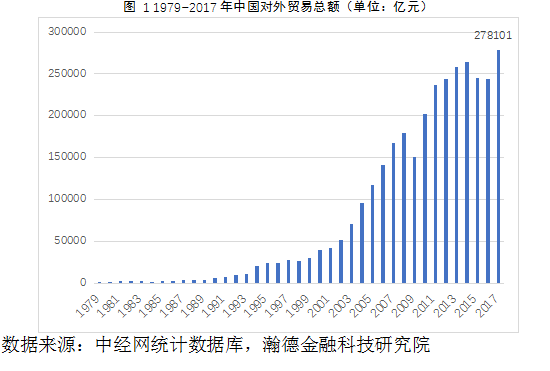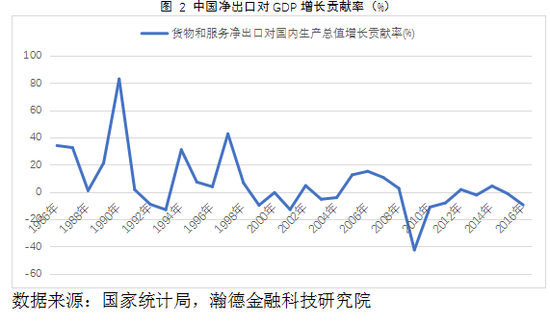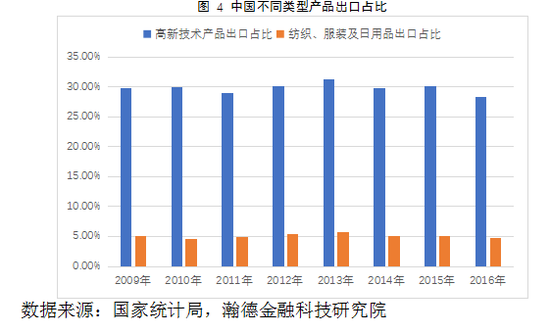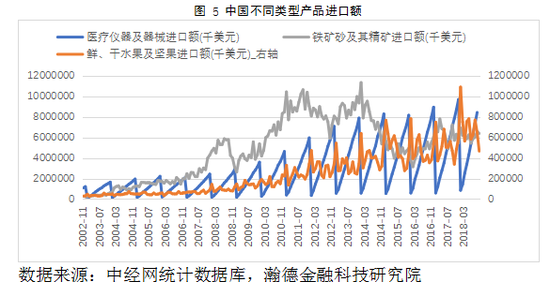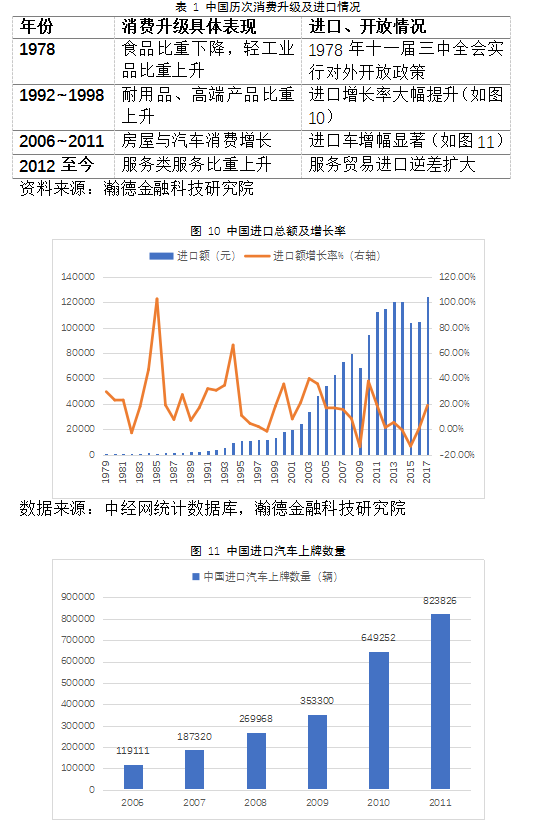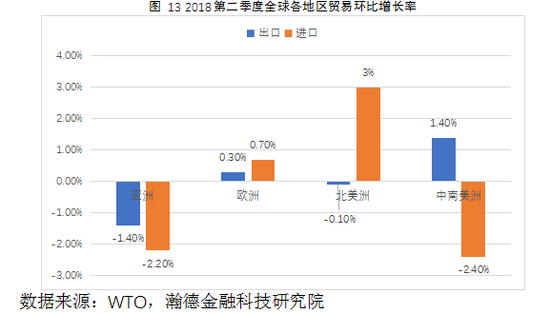Article/Yang Wang, columnist of Sina Financial Opinion Leader (WeChat official account kopleader)
The shift from export orientation to equal emphasis on import and export is a breakthrough for China from a major trading country to an economic power. At present, expanding imports is a blessing for China's residents and enterprises, and a boost to global trade for the world.
 Yang Wang, Research Fellow of International Monetary Institute of Renmin University of China
Yang Wang, Research Fellow of International Monetary Institute of Renmin University of China From November 5 to 10, 2018, the first China International Import Expo (hereinafter referred to as the Expo) attracted 172 countries, regions and international organizations to participate in the Expo, which is China's initiative to promote a higher level of opening up and shows the eye to actively grasp the important trend of economic globalization.
Opening up is an eternal proposition of economic globalization. The Expo will undoubtedly release the signal of China's stable opening up in the next stage of economic development, and it is also a key turning point for China to upgrade from an exporter to a balanced country and an economic power. So what is the practical significance of opening up imports for residents, enterprises and world trade?
What are the considerations for choosing to enter the Expo?
As a major export country in the world, China's decision to hold the Import Expo at this time reflects its determination to improve the current situation of weak export drivers.
Since the reform and opening up, China, with its strong export momentum, has become a recognized export power and driven the rapid growth of the total economic volume. In 2017, China's total foreign trade volume was 27.8 trillion yuan, ranking first in the world in terms of scale, a qualitative leap compared with 45.4 billion yuan in 1979 (as shown in Figure 1).
But in recent years, The pull of net exports on China's economy is relatively insufficient 。 Since 2009, the contribution rate of net exports to GDP growth has been negative and has remained at a low level (as shown in Figure 2). The spokesman of the National Bureau of Statistics said that the contribution rate in the first three quarters of 2018 was negative 9.8%, and the channel of relying on exports to drive the economy is gradually tightening.
Against the background of weak export drivers, it is of great significance to understand how expanding imports and opening up can effectively affect the living standards of residents, the business environment of enterprises and the overall development of the world economy through in-depth understanding of the current import and export structure and changing trends.
Export countries are concentrated, and high-tech products increase
Since 2000, more than half of China's exports have been concentrated in developed countries, with the United States, Europe and Japan taking the lead (see Figure 3). According to the data of the General Administration of Customs, in September 2018, China's export share to the United States, Europe and Japan totaled 43%.
However, The concentrated dependence on a few countries reduces the ability of foreign exports to resist risks. As shown in figure 3, since 2007, due to the impact of the U.S. financial crisis, the export trade to the United States has been significantly exceeded by Europe. The lag effect on the total export volume began to appear two years later, which is reflected in the fact that the total export volume did not rise but fell in 2009. After the outbreak of the European debt crisis in 2012, exports to Europe declined, and the growth of foreign exports slowed significantly.
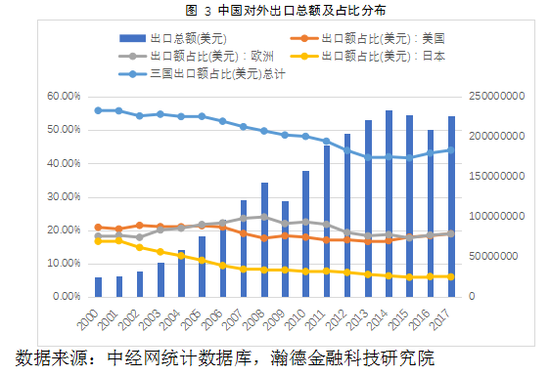
The structure of China's export products has been continuously optimized, from labor-intensive to high-tech. According to the data of the General Administration of Customs, high-tech exports exceeded labor-intensive exports for the first time in 2003, and reached 30% of the total exports in 2004. In recent years, the export proportion of high-tech products has maintained a high level, while textile and other labor-intensive products have declined to about 5%, which also tends to be stable (as shown in Figure 4).
The structure of export products focusing on high added value determines that the choice of exporting countries is relatively limited, usually around developed countries with strong consumption capacity, and this country composition is difficult to avoid the associated risk of crisis caused by exporting countries. Therefore, whether from the perspective of economic stimulus or risk control, the export oriented economic growth model needs to be changed.
Less imported basic materials and more high-end consumer goods
As shown in Figure 5, influenced by the downward trend of infrastructure and real estate investment industries, the import of iron ore and its concentrate, a representative product, began to show a downward trend in 2010. At the same time, the import of high-end consumer goods, such as nuts and medical care, grew rapidly, highlighting the strengthening of domestic consumption capacity and upgrading of consumption structure.
Service trade deficit, there is room for growth in service supply
As shown in Figure 6, from the overall scale, China's total import and export volume shows a trend of rapid growth, but it should also be noted that the trade surplus is expanding year by year, and the import and export structure is slightly unbalanced.
Focusing on the consumer side, in terms of service trade, according to the data of the Ministry of Commerce, China's total import and export of service trade in 2017 reached 4699.1 billion yuan, ranking second in the world. Contrary to the general trade situation, the service trade is in the stage of deficit, and the gap has gradually expanded in recent years (as shown in Figure 7). In 2017, the deficit of travel alone (overseas tourism, medical care, and study abroad) reached 1459.5 billion yuan. This reflects that in the context of consumption upgrading, there is a structural mismatch between domestic industrial supply and demand, the supply of the service industry is insufficient, and imports have become an important channel to meet consumer demand.
Expanding imports is the touchstone of China's stable opening up
The export led growth model is weak and has systemic risks. The transformation of the product structure at the import end and the current situation of the service trade deficit indicate the trend of upgrading both industry and consumption. The improvement of the import and export structure has become an inevitable choice to meet the current economic situation.
Expand imports and promote consumption upgrading
To a large extent, the significance of expanding imports lies in the consumer side. Consumption, as one of the "three carriages" driving the economy, has become increasingly important in the national economy. In historical experience, import and consumption tend to complement each other and promote each other.
From the world experience, consumption as the core driving force for growth is not only the law of economic development, but also the necessary way to improve national happiness. As the largest economy in the world, the proportion of consumption in GDP in the United States has remained above 70%, and even exceeded 80% in recent years (as shown in the figure). Since the reform and opening up, China's economic structure has changed, and consumption has contributed more than 50% to the growth of the national economy (as shown in Figure 9), which has become the core endogenous driving force to promote economic development.

From the perspective of domestic historical experience, all previous consumption upgrades are closely related to expanding imports. Consumption upgrading, including the expansion of scale and the evolution of structure, is closely related to the quality of national life. Since the reform and opening up, China has experienced four consumption upgrades, all of which are driven by open imports (see Table 1).
The internal reason is that expanding imports can effectively guide consumption upgrading from three aspects. First, enrich the consumption list to meet diversified needs. From the perspective of international trade theory, one of the important channels to improve consumer welfare is to expand the range of consumers' choices, reduce costs, meet diversified consumer demand, thereby improving consumer effectiveness, and expanding imports is, to a large extent, an effective supplement to the domestic consumer market.
Second, use the advantage of backwardness to promote industrial upgrading. The introduction of advanced products naturally has a positive technology spillover effect, which reduces the threshold of industrial upgrading and R&D risk costs through learning and reference.
Third, intensifying market competition and stimulating R&D innovation. The influx of imported goods will bring great pressure to domestic manufacturers in the short term, but it will form a "reverse force effect" in the long term. By improving the enthusiasm of technology research and development, the goal of optimizing the quality of goods at the supply side will be achieved.
Chinese consumers have a strong demand for imported goods. According to the Investigation and Analysis Report on Supply and Demand of Major Consumer Goods issued by the Ministry of Commerce, more than 20% of consumers spend more than 30% of their total expenditure on imported goods. For the consumer side, the significance of expanding imports to fill the existing demand gap is obvious.
Expand imports and improve enterprise efficiency
From the perspective of the global value chain, the Chinese manufacturing industry behind "Made in China" is actually still in the downstream of the global value chain, and can only obtain a small part of the added value of its value chain. Galina Hale, an economist of the Federal Reserve, once conducted a study on this issue. The study found that for every dollar spent by American consumers on "made in China" goods, an average of 55 cents went to the local service industry. In terms of labor-intensive goods such as clothing and shoes, the proportion rose to 61%.
The value added trade measurement method jointly launched by WTO and OECD is used to measure the value added of each country's exports in the global value chain. As shown in Figure 12, there is a great disadvantage in the comparison of export added value between China and its major trading partners, which is only more than India.
Expanding imports brings opportunities for enterprises to move to a higher position in the value chain. First, imports can drive the development of service industries with higher added value than imported goods. In addition, compared with processing and manufacturing, wholesale and retail belong to the field of high added value in the global value chain, and the import of non-technical products will bring enterprises far more profits than manufacturing.
also, The expansion of imports also provides support for Chinese enterprises to enter high-tech manufacturing and service industries in terms of technology and equipment. More advanced technology and equipment entering the country is a demand for improving the level of the real economy, for industrial innovation, and for improving the overall productivity of society.
Expand imports and stimulate trade vitality
In 2018, the uncertainty of the global trade environment increased, and the trade growth showed a significant decline month on month. As shown in Figure 13, compared with the global trade growth rate of 4.7% in 2017, the situation in the second quarter of 2018 was poor, with negative growth and regional imbalance.
At the moment when the vulnerability of global trade growth is rising, it is urgent to inject new impetus and tap potential markets, and the arrival of China can be said to be the dawn of the global trade dilemma. Expanding imports in the Chinese market means expanding foreign demand and providing a solid guarantee for the sustainable growth of global trade.
Since the signing of the free trade agreement in 2014, its implementation is gradually declining, and global trade protectionism and unilateral activism are on the rise, which has no low destructive power to the benign development of global trade. The establishment of a global industrial chain is a realistic reflection of market law and the foundation for the expansion of global trade and world economic growth.
According to the speech of General Secretary Xi Jinping at the Expo, it is expected that China's imports of goods and services will exceed US $30 trillion and US $15 trillion respectively in the next 15 years, which is a leap forward compared with the total global imports of goods and services of US $17 trillion and US $5 trillion in 2017. The release of the potential of China's market size will provide new opportunities for weak global trade.
Expanding imports means moving from a big trading country to an economic power
In the history of China's opening up to the outside world, the export oriented strategy has guided the long-term foreign trade practice. Experience shows that export countries are generally big trading countries, but the role of processing and manufacturing exports in improving the global trade discourse is limited.
The major importing countries are at the upstream of the global value chain, which will greatly enhance the pricing power and discourse power of domestic enterprises in trade. At the same time, import means the improvement of the domestic consumer market, and also promotes the development of services such as finance, shipping, insurance and information. Consumer countries have a natural demand driven advantage in the international division of labor system. China can expand the world's dependence on China by virtue of its huge imports, so as to build a self centered world industrial division of labor system, which is a huge opportunity to intervene and lead global economic governance.
The shift from export orientation to equal emphasis on import and export is a breakthrough for China from a major trading country to an economic power. At present, expanding imports is a blessing for China's residents and enterprises, and a boost to global trade for the world.
In the face of external doubts about China's market economy status and opening up, China's response to the world when taking the initiative to seek change also reflects the responsibility of a major country that actively participates in global economic governance.
(The author of this article introduces: Vice President of Hande Institute of Financial Science and Technology, and researcher of International Monetary Research Institute of Renmin University of China.)

